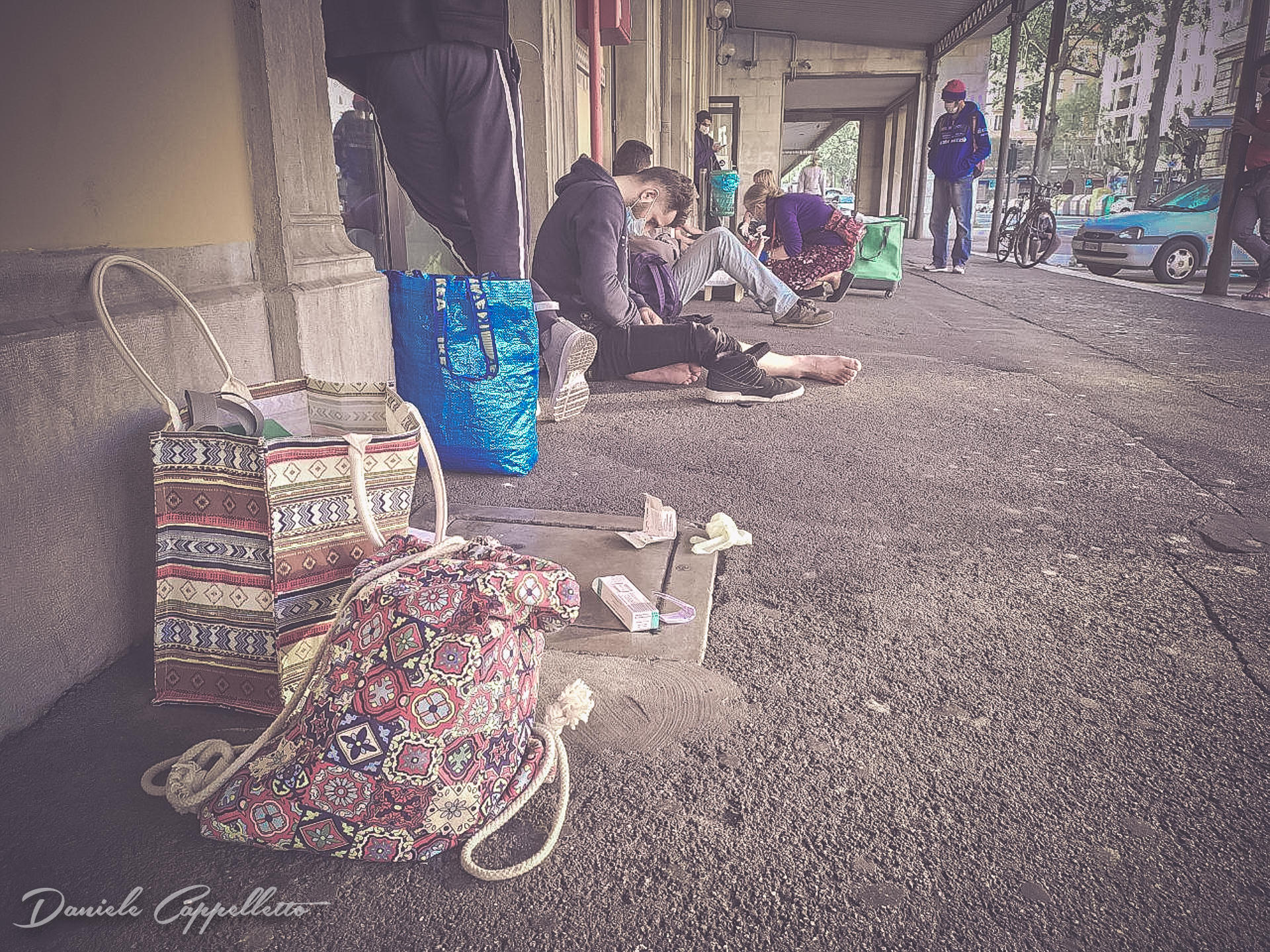Working every day in the street with people-on-the-move has allowed medical volunteers in Trieste to witness the worsening situation at the Italian border with Slovenia. Here is a sum-up of the radical changes in the last two months, highlighting growing repression towards transit groups and a spike in pushbacks from Italian territory. The events are relayed in three distinct stages: from the start of the pandemic, the development of tighter police controls, and finally the expansion of pushbacks through the dubious “informal readmission” process.
Ill-equipped for the virus
The pandemic has been an instrumental factor in recent changes at the Italian/Slovenian border. The main problem in the first days of the COVID-19 outbreak was that Trieste as a city is usually a stepping stone and not a destination in the journey of people arriving from the Balkan Route. However, due to the pandemic, many people got stuck because of the public transport halt, and the preexisting accommodation structures quickly became overcrowded. At the height of the viral outbreak, around 100 people would gather in the central square in Trieste everyday in need of assistance.
An agreement was found between volunteers of Linea d’Ombra and La Strada SiCura and the Italian police, who allowed small numbers of volunteers – in two hour rotations – to provide basic needs such as clothes, food and medical care. The number of beds was not sufficient for everyone, even if new structures were opened. The first centers for virus prevention were clearly not fit for purpose: rotation shifts for the beds, rooms with 10+ sleeping spaces, not a single specialised quarter for any case of suspect symptoms. This was made worse by the mixing and transfer of new and old people without virus sampling or prior screening.
Volunteers treating injured arrivals in Trieste (Source: Daniele Cappeletto)
Meanwhile arrivals were subject to militarized checks. On 17th March a 100 personnel of the Italian Army were sent to Trieste and the border area to “control the border and the needs of public safety”. Up to 150-170 people were found at the border in a single day, during the quarantine period as the military tightened surveillance. At this time, the transit groups were taken to police stations, fingerprinted, had asylum requests processed and were then placed in quarantine for 14 days.
Police rounding people up
In the second phase that started a few weeks into the pandemic, the police changed their attitude and started to be less tolerant towards people on the streets. Into April, groups started to be taken from the street – something that usually did not happen -, forced to ask for asylum and sent to the quarantine camps.
One episode from 14th May 2020 highlighted this change. While police forces would not usually capture people in front of volunteers, they began to wait for them to get out of their improvised shelters and, on the way back after receiving help, they were surrounded and taken to the police station. Many of these people had survived the quarantine in Trieste hiding from police without leaving their fingerprints, but in the end they were forced to ask for asylum as well.
They were all sent to quarantine structures that were supposed to house them before transfer to the other regions. For this reason, as the weeks went by, many other centers were opened – allowing the city to take in around 1000 people, some of them into tents inside the camp perimeter. People complained about the cold and the uncertainty of the situation. Some managed to escape from the quarantine and reach other cities or countries.
Tents used as overspill to hold new arrivals (Source:InfoMigrants)
The government intensified the border controls to take every arrival into custody – sometimes, even without explaining to them clearly what was going to happen. Some of them sent volunteers texts to ask about the documents they were given. They stated they were not aware they had even asked for asylum.
On 6th May 2020 volunteers on the street were greeted by police forces, Carabinieri, transport police, civil corps and militaries with automatic guns. The authorities gathered in front of the Help Center that, from winter until 18th May, had been a service next to the train station where people could get information and book a place to sleep for a couple of nights, without the need for identification. From that day on, this service to the informal population was stopped and the centers were given a list of names of people permitted to enter. Those who did not want to ask for asylum in Italy were forced again into the streets and squats of Trieste without recourse to aid.
Pushbacks from Italy
The third phase started in May. Alongside the pressure on solidarity work, it seems that a form of pushback, masked under legal pretense, had come into force. Termed as “informal readmission”, this dubious type of removal has led to the ejection of large numbers during May and early June. Italian authorities have been illegally expelling new arrivals apprehended in the border area and those found in the urban zones, notably even asylum seekers who have registered their claim for international protection. According to media reports, around 30 people appear to have been re-sent to Slovenia in just a single day. This is not the first time cases have been recorded from the Italian/Slovenian border. In August last year when BVMN recorded the pushback of a group from the area near Fernetti, who were subject to an equal level of malpractice by attending police forces. However, the development of the phenomena has shown a sharp rise in application during the COVID-19 period.
The Italian Consortium of Solidarity (ICS) and Caritas Trieste challenged this abuse of the bilateral agreement with Slovenia, arguing that “Readmissions or other forms of rejection at the border of those that intend to claim asylum are illegal”. Yet Italian authorities have been firmly in support of the violations, the vice mayor of Trieste stating:
“We have to pushback as in all the other States that care about their own inner protection. We need to give the order to pushback so that not a single person can cross our borders. The only right policy towards this problem is the use of pushback”.
In the next days there was more institutional responses from the Italian Ministry of Interior urging “more tolerance towards re-admissions to Slovenia”. As a result, pushbacks continue to this day from Trieste to Slovenia, and extend in chains through Croatia back to Serbia and Bosnia-Herzegovina, as seen in this InfoKolpa report. The Italian state argues that these are not illegal pushbacks, since they decide who goes back and who stays based on age, presence of fever, and previous fingerprints in other countries. They try to caveat the removals by saying asylum requests can be also heard in the EU-member state of Slovenia, deferring all obligations under international asylum law. The practice is being justified with an old agreement made in 1996 that allows police to readmit in Slovenia those who were found next to the border (previously it was 5 km, now within 10 km from the border and within 24 hours from their arrival).
Volunteers from Trieste spoke to some people affected by this process, who in turn shared their experience in an online video. The incident concerned a 34 year-old person that gave fingerprints in Italy on 19th May 2020 and was asked by the police to attend the station the following morning. However he was taken later that day by Italian police along with 20 other people and pushed back to Slovenia, who carried out a chain removal to Croatia, before the group were finally ejected into Serbia. In Croatia the group were beaten and the police took their money. Croatian officers told them: “If you do not give us the money, we will kill you”. One of the person’s wrist was broken in the incident, and they are now recovering in a camp in Serbia. Despite asking for asylum, the subjects of this violent removal ended up passing through three countries and having their possessions and documents stolen.
A video published recently states that Italian police forces will continue these push-backs in collaboration with Slovenia (another 40 police agents from Rome were dispatched at the border as a marker of intent). Since this rise in border controls, the number of arrivals has stayed constant, with the difference that almost everyone is intercepted at the border, diminishing the number reaching the streets of Trieste. Whether they will be accepted or re-admitted is unknown, but the threat of pushback is heightened under this new order.
What is clear is that this arrival point for the Balkan Route is becoming increasingly volatile. The observations presented by volunteers in the area are built of the evidence they can gather and the official statistics available. However, it can safely assumed that the occurrence of illegal removals at the Italian/Slovenian border are far higher, and are a trend that will continue while border authorities can act with impunity against asylum seekers and transit communities.
This report was provided by volunteers and activists of Linea d’Ombra and La Strada SiCura. You can find out more about these groups and how to support their work on their websites.

